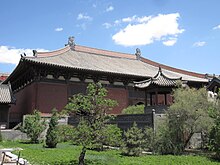Shanhua Temple
| Shanhua Temple | |
|---|---|

The temple's Mahavira Hall
|
|
| Basic information | |
| Location | Datong |
| Affiliation | Buddhist |
| Province | Shanxi |
| Country | People's Republic of China |
| Completed | 11th century |
Shanhua Temple (Chinese: 善化寺; pinyin: Shànhùa Sì) is a Buddhist temple located in Datong, Shanxi Province, China. The temple was first founded during the early 8th century of the Tang Dynasty, but its earliest surviving building dates from the 11th century. The temple was heavily repaired over the years, and today three original halls and two recently rebuilt pavilions survive. The largest, and earliest hall, dating from the 11th-century Liao Dynasty, is the Mahavira Hall and is one of the largest of its kind in China. Also historically significant are the Main Gate and Sansheng Hall, both dating from 12th century during the Jin dynasty.
The Shanhua Temple was first founded during the Kaiyuan period of the Tang Dynasty (713-741) under the patronage of emperor Xuanzong, at which time it was known as the Kaiyuan Temple. After the fall of the Tang Dynasty during the Five Dynasties period (906-960), the temple underwent a name change and was known as Da Pu’ensi. During this chaotic time, out of ten buildings at the temple, only three or four escaped destruction. After the takeover by the Liao Dynasty in 960, the temple assumed its present configuration.
The temple was again heavily damaged when the Jin dynasty took over in 1120, and in 1128 repair work was started that took fifteen years to complete. In 1421, more repairs were undertaken, this time by a monk named Dayong. In 1445, he received an imperial presentation of sutras. This is also the first time that the temple was referred to by its present name, Shanhua Temple. In the late 16th century, drum and bell towers were built on the same stone platform (yuetai, 月台) supporting the Mahavira Hall. Further repairs were made to the temple over the next two hundred years but by the late 18th century the temple was once again in a state of disrepair, and the use of one of the halls as a camel stable had caused a wall to collapse. During World War II, the Puxian pavilion was destroyed, and was rebuilt in 1953.
...
Wikipedia
